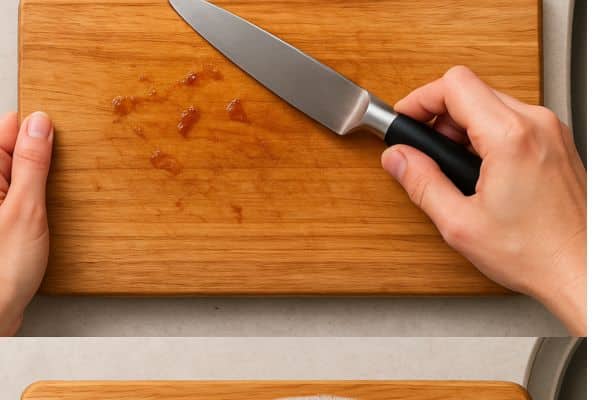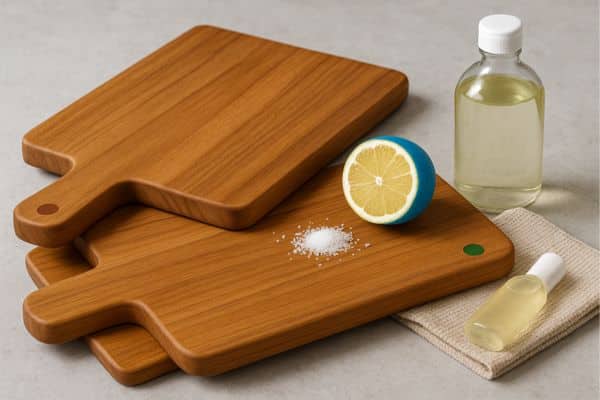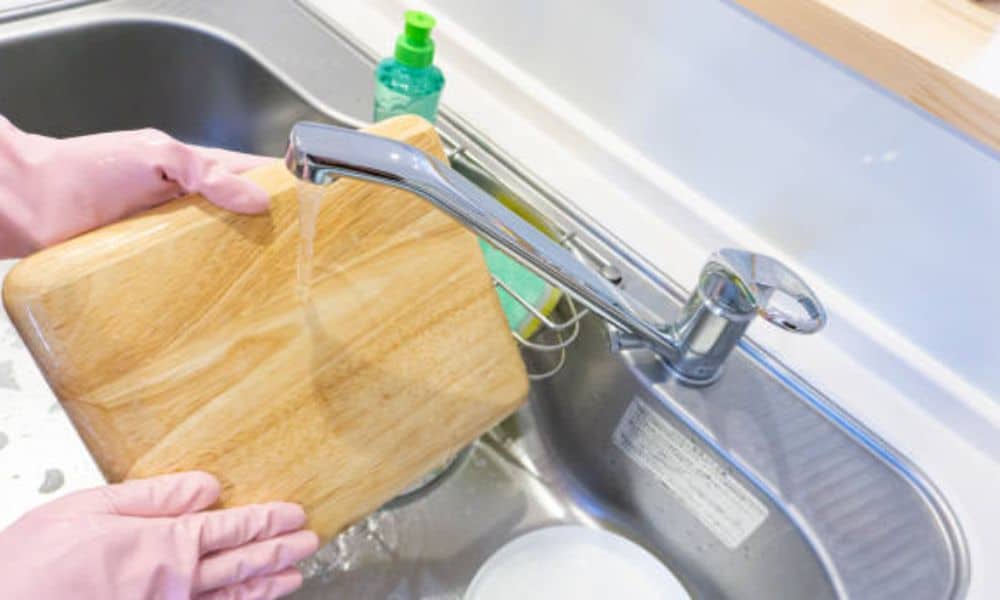Last weekend, I was cutting chicken on a wood cutting board for dinner. As I rinsed the board, I paused. Was it clean enough? I wasn’t sure. That moment stuck with me. Wood feels safe. It’s warm, strong, and lasts for years. But raw meat leaves behind things we can’t see. That’s why it helps to know how to clean a wood cutting board after raw meat.
I’ve cooked at home for years. I’ve tried vinegar, salt, and even lemon. Some worked. Some damaged the board. Over time, I found a way that’s safe, simple, and quick. This guide shares what works.
Can You Cut Raw Meat on a Wooden Cutting Board?
Yes, you can. A lot of people ask this. It’s a fair concern. Raw meat carries germs, and wood feels porous.
But here’s the truth. Wood can be safe—if it’s cleaned the right way. That’s the key. A clean board is a safe board.
Wood has a hidden skill. It pulls liquid down into the grain. Bacteria gets trapped and dries out. Over time, the germs die off inside the board.
I often use wood for meat. That includes cutting chicken on a wooden cutting board. I just clean it as soon as I’m done. Don’t wait. I don’t skip a step.
Routine care matters. It keeps fresh and strong. It keeps your food safe. And it lets you enjoy wood without worry.
01. Scrape and rinse right away

Grab a bench scraper or the back of a knife. Gently push off any meat or juice left on the board. Do this right after you finish. Then give the board a quick rinse with warm water.
02. Wash with hot, soapy water
Use dish soap and a soft sponge. Scrub the surface well. Pay extra attention to knife lines. Rinse it clean with warm water.
03. Sanitise safely
Here’s where it matters most. You need to know how to sanitize cutting board wood without harming it.
Option A: Pour white vinegar on the surface. Let it sit for 5 minutes. Rinse and wipe dry.
Option B: Mix 1 tablespoon of bleach with 1 gallon of water. Dip a clean cloth in the mix. Wipe the board. Wait 2 minutes, then rinse well.
04. Dry it the right way

Stand the board on its edge. Let it air dry in the open. This stops moisture from getting trapped.
05. Re-oil if needed
Once the board is dry, feel the surface. Does it seem rough or dry? Add a bit of food-safe mineral oil. Rub it in and let it soak overnight, then wipe away any excess.
Clean wood is happy wood. With these easy steps, your board stays fresh, safe, and long-lasting. A little care goes a long way—especially when you’re using the best cutting board for brisket to slice through those juicy, tender cuts. Regular maintenance ensures your board performs at its peak, meal after meal.
What NOT to Do When Cleaning a Wood Cutting Board
Don’t soak it in water
Soaking seems simple, but it’s not safe for wood. The board will swell, warp, or even crack. Water gets deep into the grain and stays there. That leads to damage over time.
Don’t use the dishwasher
Heat and water don’t mix well with wood. A dishwasher will dry it out and break it down. Always wash it by hand.
Don’t use harsh cleaners
Bleach can work—but only in the right mix. Strong cleaners, sprays, or rough scrubbers can strip the board. Stick to mild soap, vinegar, or a safe bleach mix.
Don’t skip cleaning after raw meat
Always clean it right away. Don’t let juices sit. Bacteria can spread fast on a warm, damp surface.
Bonus Tips for Long-Term Care

Want your board to last longer and stay fresh? A little extra care goes a long way. These quick tips help keep wood strong, clean, and ready for anything.
Use separate boards for meat and veggies
One board for raw meat. One board for fruits and greens. It’s the easiest way to avoid cross-contamination. I use colour tags or shapes to tell mine apart.
Deep clean once a week
Sprinkle coarse salt on the board. Cut a lemon in half and scrub in circles. This lifts odors and stains. It also gives a fresh, natural shine.
Condition your board monthly
Wood dries out over time. Add a small amount of food-safe mineral oil once a month. Rub it in with a soft cloth. Let it sit overnight and wipe off the extra.
Wood vs Plastic: Which Is Better for Raw Meat?
People often ask this. Is wood better than plastic? Or is plastic safer for raw meat?
The answer isn’t simple. Both have pros and cons. What matters most is how you clean and care.
Plastics are easy to toss in the dishwasher. That’s a big win. They’re light, cheap, and often used in pro kitchens. But deep knife cuts can trap bacteria. Over time, those cuts are hard to clean.
They are strong and last longer. They’re gentle on kitchen knives and look better, too. Wood can pull germs deep into the grain, where they dry out and die. That sounds odd, but it works.
Conclusion
Cleaning a wooden board after raw meat doesn’t have to be hard. Just follow a few simple steps. Scrape it, wash it, sanitize it, dry it, and oil it now and then. That’s all it takes.
A clean board keeps your kitchen safe. It protects your meals and your peace of mind. Once you build the habit, it feels easy—just part of cooking with care.
It is more than a tool. It’s part of the story you cook every day. Take care of it, and it will take care of you.


